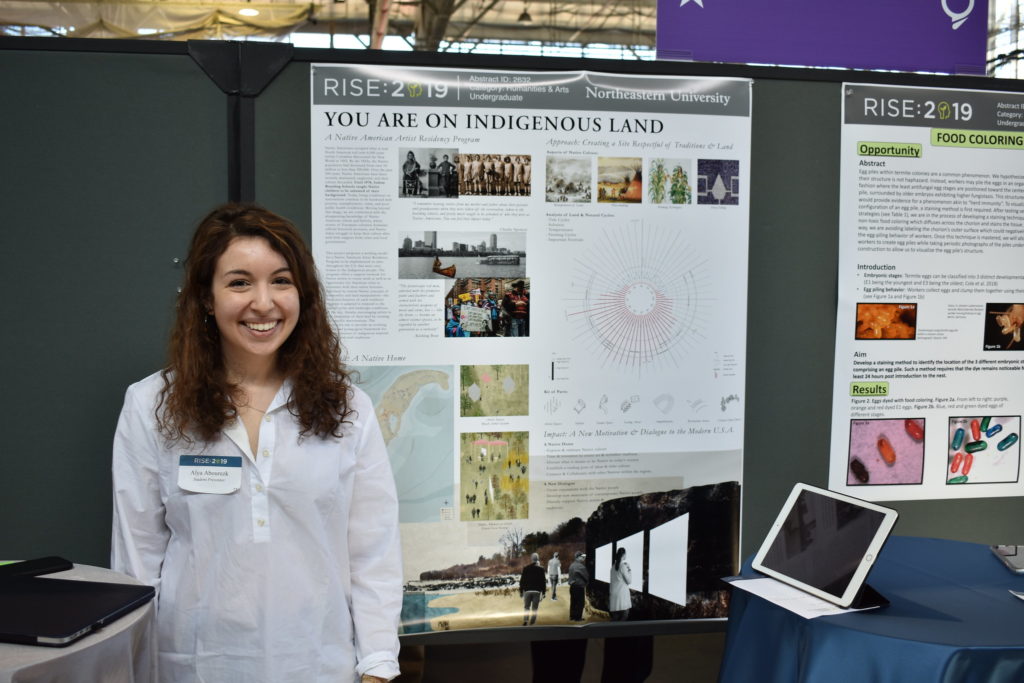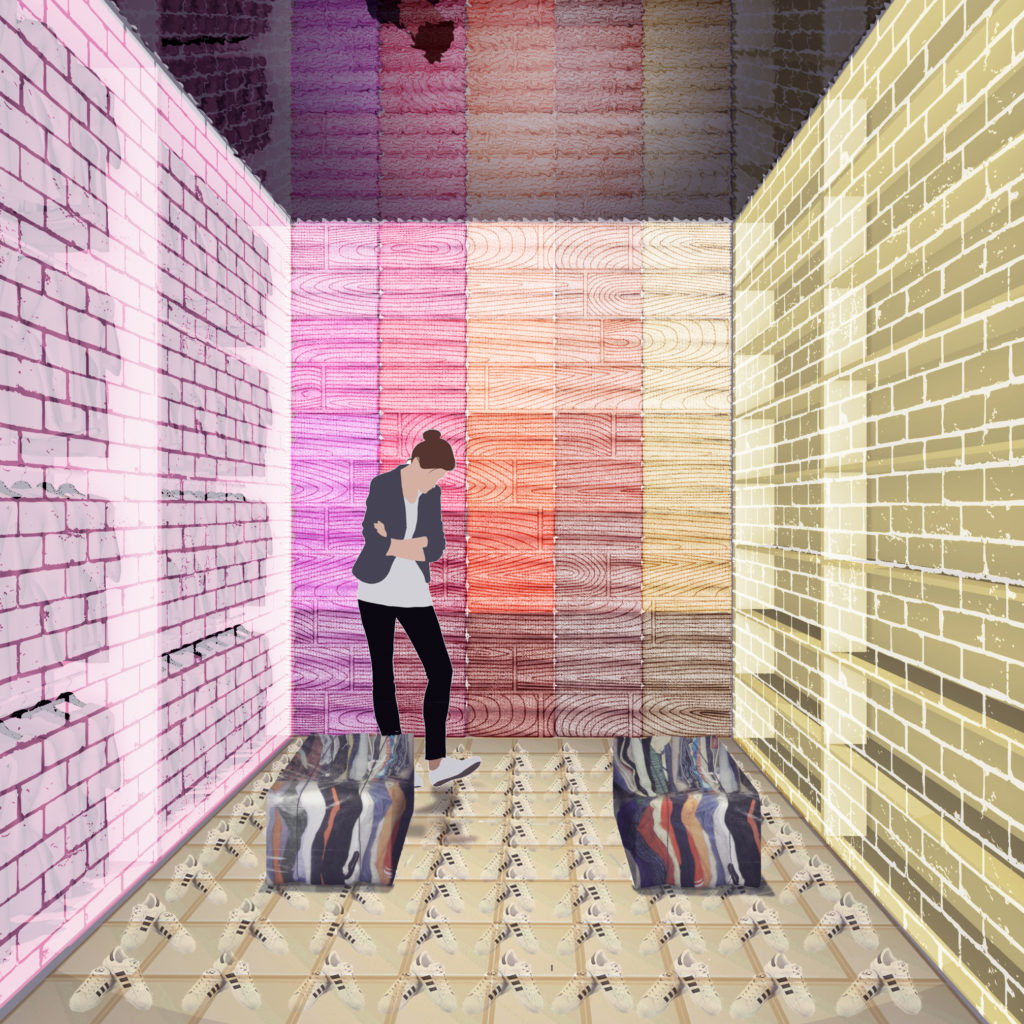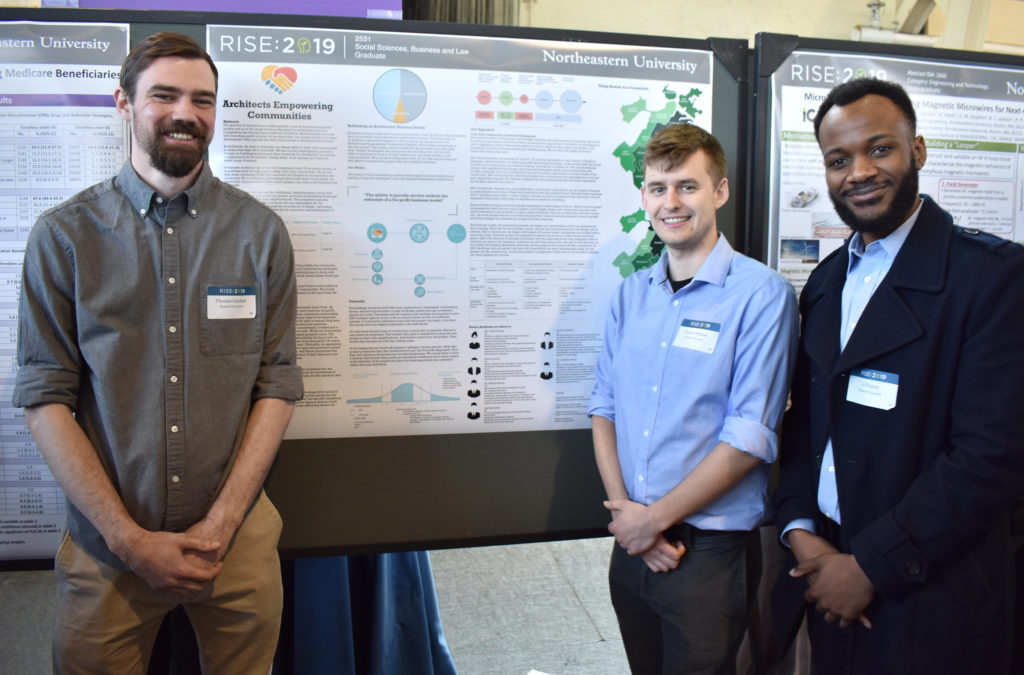Northeastern University recently held its annual Research, Innovation and Scholarship Expo. Known as RISE, the event brings together both faculty and student research at one important event. Held in the Cabot Cage each year, there are hundreds of presenters who have been nominated and vetted to be part of the expo, and share their breadth and depth of research, entrepreneurship, and scholarship with guests and judges. At the end of the event, the judges submit their ratings and the top award winners are then recognized at an afternoon reception. Students from CAMD’s School of Architecture have always been well-prepared and positioned for success for RISE; their dedication and time in studio, at critiques, and in developing large scale, thoroughly researched projects have helped them develop the skill set for independent research and innovative thinking. This year, School of Architecture undergraduate student Alya Abourezk won the RISE Humanities and Arts Award (Undergraduate) and Excellence in Scholarship Awards, while School of Architecture graduate student Nina Shabalina took home the RISE Humanities and Arts Award (Graduate). A team of Architecture students – Forrest Perkins, Al Pierre, Juste Gatari, Tom Gardner, and Hend Al Humaidan – took home the RISE Sharing Economy Award.
Alya Abourezk, who is graduating in May with her B.S. in Architecture, was recognized for her project is entitled You Are on Indigenous Land, which focuses on the diminishing Native culture within the United States as well as creating reparations from the Native American Boarding Schools that existed in the U.S. for over 100 years.

“Many of these boarding schools worked under the motto ‘Kill the Indian, save the man,’ and would take Native children away from their families and tribes and essentially teach them to be ashamed of their culture and background,” Alya said. “It was only until 1978 with the passing of the Indian Child Welfare Act, which made illegal this removal of Indian children from their homes. My project proposes a working model for a Native American Artist Residency Program to be implemented on sites throughout the U.S. that were once homes to the Indigenous people. This residency program would provide the opportunity for active Native American Artists to dedicate 1-2 weeks to create work and interact with other active Native Americans. Creating a support network would also, hopefully, motivate these Native people to keep their beautiful culture alive in the modern day.”
This is the second year in a row Alya was recognized with the RISE Humanities and Arts Award (Undergraduate), which recognizes outstanding student research. Earning this recognition was meaningful, powerful, and rewarding for Alya.
“It meant a lot to me to win this award,” she said. “The Indian Child Welfare Act was a piece of legislation that was actually authored by my father. My dad was born and raised in Wood, South Dakota on the Rosebud Indian Reservation and would later become a U.S. Senator and both found and chair the Indian Affairs Committee in the U.S. Senate. After this, both my dad and brother have served as tribal lawyers representing the Yankton Sioux Tribe, and my brother is now a tribal judge on the Pine Ridge Reservation. I, additionally, was born and raised in Sioux Falls, South Dakota and have always been fascinated by tribal art and culture. I view this project as my contribution to my family’s work. This is a project that is close to my heart and something I can definitely see myself pursuing further in the future.”
After graduating in May, Alya is planning to go back home to Sioux Falls for the summer before she moves to New York City in August to begin her Master’s in Architecture at Columbia University.
Graduate student Nina Shabalina, Master of Architecture, was also recognized with the RISE Humanities and Arts Award for her project entitled Deconstructing Materiality.

“This was a year-long research project for me,” Nina said, who conducted the research as part of her M.Arch Graduate Research Studio, which had a theme of reproduction. “The first semester was spent researching imitation in architecture, and then the research moved into material imitation. It evolved to what it is now, focusing on retail spaces, specifically short-term leases (like pop-up stores).”

Nina’s project makes the argument that in every other field, people are using imitation. In the field of Architecture, however, there is still the idea that luxury interiors, often seen in expensive retail stores, must have materials like wood and stone.
“Architects have a very conservative view when it comes to imitation,” Nina added. “I argue the importance of changing that idea and that material imitation can be interesting.”
For her research, Nina looked at various forms of imitation and explored the idea that one’s perception of a material is not just how it looks, but also how it feels, smells, etc. To her, material imitation is about taking parts of the material that speak to you and start to peel back the layers.
“To me, material imitation is about taking parts of the material that speak to you and starting to peel back the layers,” she concluded. “Being recognized at RISE and seeing that people are responding to my work, and understanding it, truly gave me the push I needed.”
Last, a group of Master of Architecture students were recognized with the RISE Sharing Economy Award for their project entitled Architects Empowering Community. This award is in the RISE Focus Award category, and grants $1,500 to the presentation demonstrating the most creative and promising approach to using technologies and algorithms for optimizing design, incentives, operations, and security of sharing economy systems. It also considers which projects enable socially desirable outcomes, such as sustainable growth, social equity and improved resilience.
For Architects Empowering Community, the students (Forrest Perkins, Al Pierre, Juste Gatari, Tom Gardner, and Hend Al Humaidan) created an alternative non-profit business model that combines architecture with development and construction. The project began during Jeremy Munn‘s Architecture Business Case Studies class; the semester-long assignment was to develop some kind of innovative start-up idea.

The group identified two issues to tackle. First, that the practice of architecture is suffering from a lack of innovative business models and is on the verge of being disrupted by technology solutions, while competition has become fierce between architects offering similar services with dwindling profit margins. The second is that, at the same time, the current model of housing development often ignores the communities in which they are located. This phenomenon can be seen in Boston as rising rents are forcing long-time residents out of their homes.
“As architects, we wanted to leverage our design skills to work with communities to create what they want and need,” team member Forrest Perkins said. “We see current development primarily focused on building housing and other amenities for the wealthy, but we see an opportunity for investment – for design skills to be opened up to serve a wider range of society. Our organization would purchase land through a partnership with local communities. We would then share ownership of the land and build on it based on the input from the community. By crowdfunding investments from individuals living within the community, to purchase land and build a project, the community becomes the developer.”
The organization would design, build and manage the building(s), retaining equity along with community investors throughout the project and local communities would get a say in what gets built in their neighborhoods. According to the team, their proposed business model would also incentivize architects who are responsible for the long term management of the property to push the boundaries of design, optimizing solutions and thus being accountable for the operation and maintenance of their innovative solutions.

“We were very unsure how this idea would be taken and so when we first presented the idea it was very rewarding to receive such positive feedback,” the team behind Architects Empowering Community concluded. “It was truly a team effort with everyone contributing a piece of the model. This is also the final semester of grad school for all of us so to finish strong and to even receive recognition through an award seems like a dream come true as school comes to an end for us.”
Congratulations to all of the students who participated in RISE, and especially to the hard-working School of Architecture students! Please browse the gallery of School of Architecture students RISE submissions in the gallery below.
[ngg src=”galleries” ids=”56″ display=”basic_imagebrowser”]


